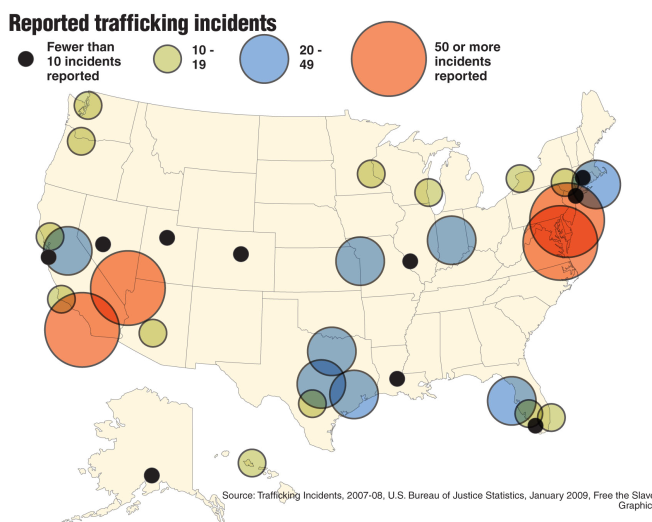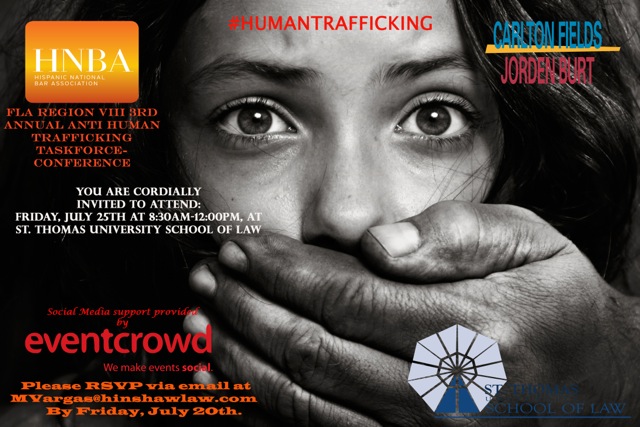To discuss an issue as complex and terrifying as human trafficking in a half hour is no easy feat. For starters, there’s the mind-blowing magnitude of a problem that claims 27 million victims worldwide, mostly women and children. This crime is also hard to spot and define, as there are infinite ways in which it manifests and weaves its way into other no-less-complex issues such as immigration, labor and human rights. Yet, my guests Ana Isabel Vallejo, Rocío Alcántar and Teresita Chavez-Pedrosa managed to offer a very thorough overview of the infinite layers that make up this worldwide crisis and its impact right here in our own country.
We learned about the main areas of concentration for this activity: From major metro areas like New York, California, South Florida to smaller, less obvious places in our own backyards. The proliferation of this crime is exacerbated by the relative isolated cultural clusters that form when there’s a diversity of people and languages, as well as the demand for cheap labor in industries like tourism, fashion and the service industries as well as in our fields and farms.

The very nature of the crime allows it to hide itself in plain sight, behind the façade of similar criminal activities, which gives traffickers the upper hand as they look for vulnerable people in situations they can exploit. According to my guests, the following are some of the vulnerability red flags that may lead to a potential human trafficking situation:
- People who are clearly controlled by someone else, such as a pimp or “employer,” has no identification documents or appears not to have freedom of will or movement
- People working in substandard or servant-like conditions
- Children who don’t have the traditional guardians present, i.e. those in foster care and/or unaccompanied immigrant minors, who may encounter traffickers on their way to the U.S.
- Single mothers in need of money to support their children
- Girls without parental support, socially isolated, depressed. For these girls, it may come in the form of a manipulative boyfriend
- People with disabilities or mental health issues
- Alcohol or drug addiction
- Homelessness
- College students/Youth in financial need lured into relationships in exchange for money
As usual, I’ve compiled some of my favorite, ready-to-tweet quotes from my guests:
- “Get educated. Keep an eye on children around you.” ~ Teresa Chavez-Pedrosa [Tweet this]
- “Try to find out what organizations are working on #humantrafficking and get involved.” ~ Ana Isabel Vallejos [Tweet this]
- “Donate financially to organizations doing this kind of work.” ~Rocío Alcántar [Tweet this]
- “We have to be very aware of what’s our complicity as consumers, as individuals, in wanting to purchase cheap goods that in turn lead to the need for large amounts of cheap labor.” ~ Ana Isabel Vallejos [Tweet this]
As my guests pointed out, there is help. If you know anyone in any of these situations or are a victim, here are some legal resources that were mentioned during the broadcast. Please share these and any others you may know of in the comments — You may help save a life!
- H.R.898 – Trafficking Victims Protection Reauthorization Act of 2013
- National Human Trafficking Hotline 888-373-7888 or text BeFree (233733) CONFIDENTIAL HELP & INFO 24/7
- U.S Department of State reports on human trafficking 2001- 2013
- Contact your country’s embassy to find out what programs they have in place to help victims of human trafficking
Existing immigration mechanisms to provide protection from deportations or “continued presence” while investigations are pending:
- T Non-Immigrants Status Visa for victims of trafficking
- U Non-Immigrant Status Visa for victims of violent crimes
- Information on how family members can apply for protections prior to issue of visa — U Non-Immigrant Derivative Visa
Legislation at the state level:
- Illinois Safe Children’s Act
- California : Social services for victims
- Florida Protections To Victims Of Trafficking
- The app Buycott uses a barcode scanner to look up a product, determine what brand it belongs to, and figure out what company owns that brand and who owns that company and tells you whether the company engages in fair practices.
Here are some resources/organizations where you can learn more about this issue and get involved (Including the sites for my guests):
- VIDA Legal Assistance – Ana Isabel’s organization
- National Immigrant Justice Center (NIJC) – where Rocío practices as Supervising Attorney
- Hispanic National Bar Association – Florida Region – Of which Teresita is the former President
- St. Thomas University
- National Resource Center for Human Trafficking – Polaris project
- Freedom Network USA
Upcoming Events on Human Trafficking and Justice:
- Human Trafficking Academy at St. Thomas University – Happening July 28 – August 1, 2014
- 3rd Annual HNBA Florida Region VIII Anti Human Trafficking Taskforce-Conference – Happening July 25, 2014 (Details on flyer below)

